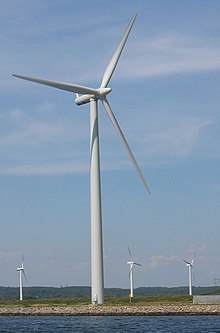
Back تعويض الكربون Arabic Compensació de carboni Catalan Uhlíková kompenzace Czech Klimakompensation German Αντιστάθμιση άνθρακα Greek Compensación de carbono Spanish آفست کربن Persian Päästökompensaatio Finnish Compensation carbone French Creidmheasanna agus fritháireamh carbóin Irish

| Part of a series on |
| Climate change and society |
|---|
| Part of a series on |
| Climate change mitigation |
|---|
| Part of a series about |
| Environmental economics |
|---|
 |
Carbon offsetting is a carbon trading mechanism that enables entities to compensate for offset greenhouse gas emissions by investing in projects that reduce, avoid, or remove emissions elsewhere. When an entity invests in a carbon offsetting program, it receives carbon credit or offset credit, which account for the net climate benefits that one entity brings to another. After certification by a government or independent certification body, credits can be traded between entities. One carbon credit represents a reduction, avoidance or removal of one metric tonne of carbon dioxide or its carbon dioxide-equivalent (CO2e).
A variety of greenhouse gas reduction projects can qualify for offsets and credits depending on the scheme. Some include forestry projects that avoid logging and plant saplings,[1][2] renewable energy projects such as wind farms, biomass energy, biogas digesters, hydroelectric dams, as well as energy efficiency projects. Further projects include carbon dioxide removal projects, carbon capture and storage projects, and the elimination of methane emissions in various settings such as landfills. Many projects that give credits for carbon sequestration have received criticism as greenwashing because they overstated their ability to sequester carbon, with some projects being shown to actually increase overall emissions.[3][4][5][6]
Carbon offset and credit programs provide a mechanism for countries to meet their Nationally Determined Contributions (NDC) commitments to achieve the goals of the Paris Agreement.[7] Article 6 of the Paris Agreement includes three mechanisms for "voluntary cooperation" between countries towards climate goals, including carbon markets. Article 6.2 enabled countries to directly trade carbon credits and units of renewable power with each other. Article 6.4 established a new international carbon market allowing countries or companies to use carbon credits generated in other countries to help meet their climate targets.
Carbon offset and credit programs are coming under increased scrutiny because their claimed emissions reductions may be inflated compared to the actual reductions achieved.[8][9][10] . The Australia Institute highlights 23 instances where carbon offset schemes were found to have significant shortcomings.[11] These include claims of overestimated carbon sequestration, double-counting of credits, and the failure of projects to provide additional environmental benefits beyond what would have occurred naturally.
To be credible, the reduction in emissions must meet three criteria: they must last indefinitely, be additional to emission reductions that were going to happen anyway, and must be measured, monitored and verified by independent third parties to ensure that the amount of reduction promised has in fact been attained.[12] [13]
- ^ a b Hamrick, Kelley; Gallant, Melissa (May 2017). "Unlocking Potential: State of the Voluntary Carbon Markets 2017" (PDF). Forest Trends' Ecosystem Marketplace. p. 10. Archived (PDF) from the original on 2020-08-14. Retrieved 2019-01-29.
- ^ Haya, Barbara K.; Evans, Samuel; Brown, Letty; Bukoski, Jacob; Butsic, Van; Cabiyo, Bodie; Jacobson, Rory; Kerr, Amber; Potts, Matthew; Sanchez, Daniel L. (2023-03-21). "Comprehensive review of carbon quantification by improved forest management offset protocols". Frontiers in Forests and Global Change. 6. Bibcode:2023FrFGC...6.8879H. doi:10.3389/ffgc.2023.958879. ISSN 2624-893X.
- ^ Greenfield, Patrick (2023-01-18). "Revealed: more than 90% of rainforest carbon offsets by biggest certifier are worthless, analysis shows". The Guardian. ISSN 0261-3077. Retrieved 2024-07-30.
- ^ Blake, Heidi (2023-10-16). "The Great Cash-for-Carbon Hustle". The New Yorker. ISSN 0028-792X. Retrieved 2024-07-30.
- ^ Greenfield, Patrick (2023-08-24). "Carbon credit speculators could lose billions as offsets deemed worthless". The Guardian. ISSN 0261-3077. Retrieved 2024-07-30.
- ^ Masie, Desné (2023-08-03). "Are carbon offsets all they're cracked up to be? We tracked one from Kenya to England to find out". Vox. Retrieved 2024-07-30.
- ^ "Climate Explainer: Article 6". World Bank. Retrieved 2023-03-29.
- ^ "Goldman School of Public Policy | Goldman School of Public Policy | University of California, Berkeley". gspp.berkeley.edu. Retrieved 2023-12-28.
- ^ Probst, Benedict; Toetzke, Malte; Anadon, Laura Diaz; Kontoleon, Andreas; Hoffmann, Volker (2023-07-27). Systematic review of the actual emissions reductions of carbon offset projects across all major sectors (Report). In Review. doi:10.21203/rs.3.rs-3149652/v1. hdl:20.500.11850/620307.
- ^ Cite error: The named reference
:1was invoked but never defined (see the help page). - ^ "Here are 23 Times Carbon Offsets Were Found to be Dodgy". The Australia Institute. 23 January 2024.
{{cite news}}: CS1 maint: url-status (link) - ^ Hawken, Paul, ed. (2021). Regeneration: ending the climate crisis in one generation. New York: Penguin Books. ISBN 978-0-14-313697-2.
- ^ Batjes, N.H.; Ceschia, E.; Heuvelink, G.B.M.; Demenois, J.; le Maire, G.; Cardinael, R.; Arias-Navarro, C.; von Egmond, F. (October 2024). "Towards a modular, multi-ecosystem monitoring, reporting and verification (MRV) framework for soil organic carbon stock change assessment". Carbon Management. 15 (1): 2410812. doi:10.1080/17583004.2024.2410812.